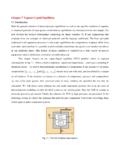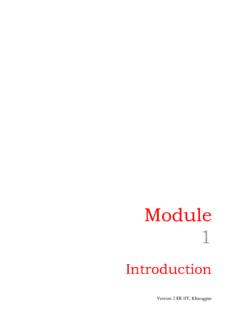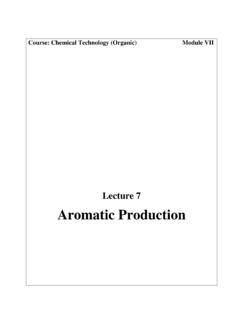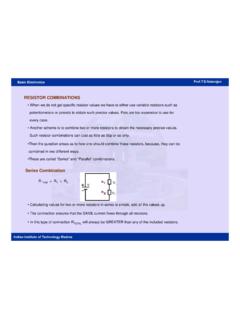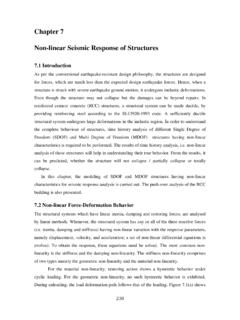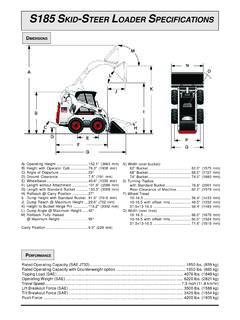Transcription of Lecture 1 Corrosion: Introduction Definitions and Types
1 Lecture 1: corrosion : Introduction Definitions and Types NPTEL Web Course 1 Course Title: Advances in corrosion Engineering Course Co-ordinator: Prof. K. A. Natarajan, IISc Bangalore Lecture 1 corrosion : Introduction Definitions and Types Keywords: Definition of corrosion , corrosion Types , Environment. corrosion can be viewed as a universal phenomenon, omnipresent and omnipotent. It is there everywhere, air, water, soil and in every environment, we encounter. There is no single figure for loss to the nation due to corrosion . It can be a minimum of of the nation s GDP. Losses due to corrosion could be around Rs. lakh crores per annum in India. corrosion costs manifest in the form of premature deterioration or failure necessitating maintenance, repairs and replacement of damaged parts. In the US, total direct cost of corrosion is estimated at about 300 billion dollars per year; which is about of domestic product.
2 corrosion has a huge economic and environmental impact on all facets of national infrastructure; from highways, bridges, buildings, oil and gas, chemical processing, water and waste water treatment and virtually on all metallic objects in use. Other than material loss, corrosion interferes with human safety, disrupts industrial operations and poses danger to environment. Awareness to corrosion and adaptation of timely and appropriate control measures hold the key in the abatement of corrosion failures. Definitions : corrosion is the deterioration or destruction of metals and alloys in the presence of an environment by chemical or electrochemical means. In simple terminology, corrosion processes involve reaction of metals with environmental species. Lecture 1: corrosion : Introduction Definitions and Types NPTEL Web Course 2 Course Title: Advances in corrosion Engineering Course Co-ordinator: Prof.
3 K. A. Natarajan, IISc Bangalore As per IUPAC, corrosion is an irreversible interfacial reaction of a material (metal, ceramic, polymer) with its environment which results in its consumption or dissolution into the material of a component of the environment. Often, but not necessarily, corrosion results in effects detrimental to the usage of the material considered. Exclusively physical or mechanical processes such as melting and evaporation, abrasion or mechanical fracture are not included in the term corrosion With the knowledge of the role of various microorganisms present in soil and water bodies, the definition for corrosion need be further widened to include microbially-influenced factors. corrosion can be classified in different ways, such as Chemical and electrochemical High temperature and low temperature Wet corrosion and dry corrosion . Dry corrosion occurs in the absence of aqueous environment, usually in the presence of gases and vapours, mainly at high temperatures.
4 Electrochemical nature of corrosion can be understood by examining zinc dissolution in dilute hydrochloric acid. Zn + 2 HCl = ZnCl2 + H2 Anodic reaction is Zn = Zn++ + 2e with the reduction of 2H+ + 2e = H2 at cathodic areas on the surface of zinc metal. There are two half reactions constituting the net cell reaction. Environmental effects such as those of presence of oxygen and other oxidizers, changes in flow rates (velocity), temperature, reactant concentrations and pH would influence rates of anodic and cathodic reactions. Lecture 1: corrosion : Introduction Definitions and Types NPTEL Web Course 3 Course Title: Advances in corrosion Engineering Course Co-ordinator: Prof. K. A. Natarajan, IISc Bangalore Even though the fundamental mechanism of corrosion involves creation or existence of corrosion cells, there are several Types or forms of corrosion that can occur. It should however be borne in mind that for corrosion to occur, there is no need for discrete (physically independent) anodes and cathodes.
5 Innumerable micro level anodic and cathodic areas can be generated at the same (single) surface on which anodic ( corrosion ) and cathodic (reduction) reactions occur. Each form of corrosion has a specific arrangement of anodes and cathodes and specific patterns and locations depending on the type can exist. The most important Types are Uniform corrosion . Galvanic corrosion , concentration cells, water line attack Pitting. Dezincification, Dealloying (selective leaching) Atmospheric corrosion . Erosion corrosion Fretting Crevice corrosion ; cavitation Stress corrosion , intergranular and transgranular corrosion , hydrogen cracking and embrittlement corrosion fatigue. Lecture 1: corrosion : Introduction Definitions and Types NPTEL Web Course 4 Course Title: Advances in corrosion Engineering Course Co-ordinator: Prof. K. A. Natarajan, IISc Bangalore Table ASM classifications of corrosion Types General corrosion : Localized corrosion : Metallurgically Influenced corrosion : Mechanically Assisted Degradation: Environmentally Induced Cracking: Corrosive attack dominated by uniform thinning Atmospheric corrosion Galvanic corrosion Stray-current corrosion General biological corrosion Molten salt corrosion corrosion in liquid metals High temperature corrosion High rates of metal penetration at specific sites Crevice corrosion Filiform corrosion Pitting corrosion Localized biological corrosion Affected by alloy chemistry & heat treatment Intergranular corrosion Dealloying corrosion corrosion with a mechanical component Erosion corrosion Fretting corrosion Cavitation and water drop impingement corrosion fatigue Cracking produced by corrosion , in the presence of stress.
6 Stress corrosion Cracking (SCC) Hydrogen Damage Liquid metal embrittlement Solid metal induced embrittlement (Ref: Sully J R, Taylor D. W, Electrochemical Methods of corrosion Testing, Metals Hand Book. Vol 13, 1987.) Lecture 1: corrosion : Introduction Definitions and Types NPTEL Web Course 5 Course Title: Advances in corrosion Engineering Course Co-ordinator: Prof. K. A. Natarajan, IISc Bangalore Crevice corrosion is a localized attack on a metal adjacent to the crevice between two joining surfaces (two metals or metal-nonmetal crevices). The corrosion is generally confined to one localized area to one metal. This type of corrosion can be initiated by concentration gradients (due to ions or oxygen). Accumulation of chlorides inside crevice will aggravate damage. Various factors influence crevice corrosion , such as. Materials: alloy composition, metallographic structure. Environmental conditions such as pH, oxygen concentration, halide concentrations, temperature.
7 Geometrical features of crevices, surface roughness. Metal to metal or metal to nonmetal type. Filiform corrosion is a special type of crevice corrosion . Pitting corrosion is a localized phenomenon confined to smaller areas. Formation of micro-pits can be very damaging. Pitting factor (ratio of deepest pit to average penetration) can be used to evaluate severity of pitting corrosion which is usually observed in passive metals and alloys. Concentration cells involving oxygen gradients or ion gradients can initiate pitting through generation of anodic and cathodic areas. Chloride ions are damaging to the passive films and can make pit formation auto-catalytic. Pitting tendency can be predicted through measurement of pitting potentials. Similarly critical pitting temperature is also a useful parameter. Uniform corrosion is a very common form found in ferrous metals and alloys that are not protected by surface coating or inhibitors.
8 A uniform layer of rust on the surface is formed when exposed to corrosive environments Atmospheric corrosion is a typical example of this type. Lecture 1: corrosion : Introduction Definitions and Types NPTEL Web Course 6 Course Title: Advances in corrosion Engineering Course Co-ordinator: Prof. K. A. Natarajan, IISc Bangalore Galvanic corrosion often referred to as dissimilar metal corrosion occurs in galvanic couples where the active one corrodes. EMF series (thermodynamic) and galvanic series (kinetic) could be used for prediction of this type of corrosion . Galvanic corrosion can occur in multiphase alloys. Eg: - Copper containing precipitates in aluminium alloys. Impurities such as iron and copper in metallic zinc. Differential aeration (oxygen concentration cell) and ion concentration (salt concentration) cells create dissimilar polarities (anodic and cathodic areas) Eg:-Pitting of metals.
9 Rusting of iron (Fig. ). Fig. Differential oxygen cells in rusting of iron Selective leaching (Dealloying) refers to selective dissolution of active metal phase from an alloy in a corrosive environment. Lecture 1: corrosion : Introduction Definitions and Types NPTEL Web Course 7 Course Title: Advances in corrosion Engineering Course Co-ordinator: Prof. K. A. Natarajan, IISc Bangalore Examples: a) Brass containing copper and zinc. Since zinc is anodic to copper, selective dezincification occurs in a corrosive medium, enriching the cathodic copper in the matrix (colour of brass turns red from yellow). b) Graphitization of grey cast iron-graphite being cathodic enhances dissolution of iron in the matrix, leaving behind a graphite network. There are several other examples of dealloying besides the above. Tin Bronzes in hot brine or steam-Destannification. Precious metal alloys such as gold containing copper or silver strong acids, sulfide environment - preferential dissolution of copper or silver.
10 Cupro-nickel alloys in condenser tubes-denickelisation. Localised attack at or nearer to grain boundaries in a metal or alloy can be termed as intergranular corrosion . Generally the following factors contribute to intergranular corrosion . Impurities and precipitation at grain boundaries. Depletion of an alloying element (added to resist corrosion ) in the grain-boundary area. A typical example is sensitized 18-8 stainless steels when chromium carbide is precipitated along grain boundaries. Lowered chromium content in the area adjacent to grain boundaries, leads to formation of anodic and cathodic areas. Such intergranular corrosion is common in stainless steel welded structures and is referred to as weld decay. Intergranular attack can occur in other alloys as well. For example, Duralumin-type alloys (Al Cu) due to precipitation of CuAl2. Lecture 1: corrosion : Introduction Definitions and Types NPTEL Web Course 8 Course Title: Advances in corrosion Engineering Course Co-ordinator: Prof.

